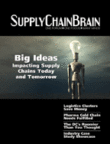
Home » The Power of Design to Define the Brand
The Power of Design to Define the Brand

December 18, 2012
Successful marketing in the business-to-business space requires a deep understanding of industry and channel dynamics. That's true regardless of the vertical, says Sullivan, but it certainly is the case in logistics and supply chain. Consequently, developing a brand personality helps communicate a company's purpose and values to customers. Princeton Partners has worked with a number of transportation and logistics companies, including Pacer, to develop successful B2B marketing strategies. In this interview, at the annual TMSA conference, held this year in Hollywood, Florida, Sullivan explained how the right design can define your brand.
Q: Perhaps it would be useful to start by defining what is meant by the word "brand." What does that mean?
A: Sullivan: The default answer is that you define a brand by logo or by a name, yet corporations that have done a real good job of defining "brand" start with the idea that brand is defined by the consumer.
Q: How is that?
A: Sullivan: It's defined in the brain and in the mind. The best definition I ever heard is that brand is the sum total of all ideas and thoughts and experiences and emotions the consumer has had about that brand and in relationship to that brand.
That's kind of intangible, but the most amazing brands have had the power to really define narrowly the boundaries of what that brand stands for. Simple ideas like "trust" or "happiness" or "reliability." Singular concepts, but they've done a really good job over the years focusing on them - like Volvo has on safety - to define the ideas that are associated with that company name and that logo and idea and brand.
Q: We're talking about design affecting or defining the brand, but somebody might ask if it isn't really the other way around: that the brand actually defines the design. What do you say?
A: Sullivan: I won't disagree with that. It's an integrated process. The process of creating a brand truly starts with business strategy, mission, vision and values. It starts with the purpose of the organization - why do you exist, right?
It's a vision or aspiration, where you feel your company will take a customer of the future someplace in a better way than a competitor might because of the values of a culture.
All of that, yes, those strategic issues come down to who a company is, and that must influence a design. But ironically it's the design that takes over and begins to influence in the long term.
Q: Is there an example?
A: Sullivan: Yes. The Coca-Cola symbol has bee around for well over a 100 years. That begins to communicate to the marketplace globally what Coca-Cola is all about. And people can expect that in any language anywhere in the world, rich or poor, they will understand what to experience. That Coca-Cola design has now infiltrated everybody who is in bottling or production or marketing or, at the facing of the consumer, right down to the experience when they serve a Coke.
Q: Let's contrast marketing in the B2B world with that in the consumer world. Differences? Similarities?
A: Sullivan: Naturally, we think in B2B that we're more sophisticated, more important, more serious. But look at this; think about UPS, for example. UPS has gone to market with "We love logistics." They're proud of brown - they own that color. They own, essentially, the ability to satisfy a need and to create appreciation for the complexity of logistics, to give us a peek inside that, and 'Oh, there's value in that. I didn't know that's how that happened.'
They approached that just like a consumer. There's no real difference in the recipient of a brand communication, whether it's a business buyer or a consumer buyer.
Q: Why not? Aren't our needs different?
A: Sullivan: Our minds work the same way, and they often work primarily on emotional attraction first. Then it gets more sophisticated in the B2B brand in that it has to be supported by rational propositions that have to be built into the brand strategically. B2B marketing requires, yes, that your corporate personality has to come through, but your promise to those segments as well as your proof that supports those promises must be well articulated as well. I think that brand has the ability, through design, to communicate that more effectively whether that business communication is through a web site, sales presentations or other collateral.
But at the end of the day, it's about how we as human beings react to basic things like color, like typeface, like visual elements and icons. Simplicity has often been the root of the best design, and the best brands in B2B have been able to accomplish that as well.
Q: Is it your view that brand design can influence an organization as well?
A: Sullivan: Most definitely it can. That's because organizations are in a constant state of change: new people, new challenges, new business, new services. To be successful, organizations have to stay current with the trends. At the end of the day, they have to achieve their core purpose.
Q: Do you have an example? A client, perhaps?
A: Sullivan: Take a brand in our industry, like Pacer - it's an intermodal company, it has NVOCC operations, logistics business. It has a lot of components. How do you put those components together? Pacer decided it was going to communicate to customers through a new brand design, a new logo, the flying "P", with the combined tagline of 'Making your world run smoother.'
That promise that they're putting out there is communicated through brand and logo and design, and there's a requirement for those individuals when they show up in the morning, whether in transportation management or retail logistics or any aspect of the business, they have to know that it's their job to make their customers' world run smoother. So they're focused efficiency, on quality improvement and reliability.
Q: What, if anything, influences brand design?
A: Sullivan: Largely, the digital world: the internet, the web and, most amazingly, the acceleration of social media channels. Literally thousands of channels, specific channels, industry channels, as well as the common social channels. That's where the dialog is taking place.
The No. 1 rule I recommend is consistency. Don't shy away from that, from social media. You need to play in those channels and find creative ways to do it. For example, I like Jeep. It's a great American brand, started in WWII. They manufactured Jeeps, built a consumer base with G.I.s, continued to deliver performance and happiness, and they've developed a subculture.
So how do you get that Jeep brand design into the social media landscape? In their case, with Twitter. They enabled people to participate in Twitter conversations, drive them back to that Twitter sub-page and participate in contests that enabled them to create designs. It's specialized, it's esoteric, but it's creative thinking. And I think that's what's required to engage in, whether it's transportation management companies, the railroads, whatever. We have an international marketplace. We have a responsibility to use all tools because people are finding us for solutions. So I say, 'Consistency but combined with creativity.'
Don't lose your brand design, your brand purpose and your personality and basic fundamentals that support the brand, but make sure they are articulated in ways that are relevant in social media.
To view the video of this interview online, click here
Resource Link:
Princeton Partners
Keywords: supply chain, value chain, B2B marketing transportation companies, marketing logistics and transportation management
RELATED CONTENT
RELATED VIDEOS
KEYWORDS B2B marketing transportation companies Business Strategy Alignment Global Supply Chain Management High-Tech/Electronics marketing logistics and transportation management supply chain Supply Chain Analysis & Consulting Value chain
Subscribe to our Daily Newsletter!
Timely, incisive articles delivered directly to your inbox.
Popular Stories
-

-

Diversifying Production From China: Welcome to ‘The Great Reallocation’
-

U.S. Fleet Professionals Look Toward Sustainability to Cut Down on Rising Operating Costs
-

Next-Generation Packaging Brings Reliability and Visibility to Supply Chains
-

In the Transition to Electric Vehicles, Components Sourcing Will Be a Growing Challenge

2024 Supply Chain Management Resource Guide: There's Only One Way Off a Burning Platform
VIEW THE LATEST ISSUECase Studies
-
Recycled Tagging Fasteners: Small Changes Make a Big Impact
-

Enhancing High-Value Electronics Shipment Security with Tive's Real-Time Tracking
-

Moving Robots Site-to-Site
-
JLL Finds Perfect Warehouse Location, Leading to $15M Grant for Startup
-
Robots Speed Fulfillment to Help Apparel Company Scale for Growth